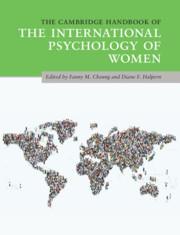Book contents
- The Cambridge Handbook of the International Psychology of Women
- The Cambridge Handbook of the International Psychology of Women
- Copyright page
- Dedication
- Contents
- Figures
- Tables
- Contributors
- Acknowledgments
- Section 1 The Underpinnings of Sex and Gender and How to Study Them
- Section 2 Developmental Perspectives of the International Psychology of Women
- 6 Sex Differences in Early Life
- 7 Gender and Adolescent Development across Cultures
- 8 Fertility, Childbirth, and Parenting
- 9 Three Ways that Aging Affects Women Differently from Men
- Section 3 Cognitive and Social Factors
- Section 4 Work and Family Issues
- Section 5 Inequality and Social Justice
- Section 6 Health and Well-Being
- Epilogue Some Final Thoughts and Take-Home Messages
- Index
- References
8 - Fertility, Childbirth, and Parenting
Defining Sexual and Gender Relations
from Section 2 - Developmental Perspectives of the International Psychology of Women
Published online by Cambridge University Press: 20 July 2020
- The Cambridge Handbook of the International Psychology of Women
- The Cambridge Handbook of the International Psychology of Women
- Copyright page
- Dedication
- Contents
- Figures
- Tables
- Contributors
- Acknowledgments
- Section 1 The Underpinnings of Sex and Gender and How to Study Them
- Section 2 Developmental Perspectives of the International Psychology of Women
- 6 Sex Differences in Early Life
- 7 Gender and Adolescent Development across Cultures
- 8 Fertility, Childbirth, and Parenting
- 9 Three Ways that Aging Affects Women Differently from Men
- Section 3 Cognitive and Social Factors
- Section 4 Work and Family Issues
- Section 5 Inequality and Social Justice
- Section 6 Health and Well-Being
- Epilogue Some Final Thoughts and Take-Home Messages
- Index
- References
Summary
Major historical shifts in the field of fertility, childbirth, and parenting have implications for feminist psychologists working on these topics. These shifts include approaches to sexuality and reproduction: a population control emphasis in the late 1940s, a reproductive rights paradigm in the 1990s, and progression from reproductive rights to reproductive justice. Feminist psychologists have to traverse the political landscape created by these broad approaches. In this chapter, we suggest ways in which such engagement may be facilitated through examination of mainstream assumptions and outcomes and the use of nuanced feminist research. Drawing from transnational feminisms, the principles of reproductive justice, and examples of research and interventions in reproductive decision-making, abortion, obstetric violence, "deviant" (m)others, early reproduction, and contraception, we argue that feminist psychology should attend to both global and cross-cutting power relations concerning fertility and reproduction, as well as localized dynamics.
Keywords
- Type
- Chapter
- Information
- The Cambridge Handbook of the International Psychology of Women , pp. 110 - 123Publisher: Cambridge University PressPrint publication year: 2020
References
Suggested Readings
This chapter is based on research supported by the South African Research Chairs initiative of the Department of Science and Technology and National Research Foundation of South Africa, grant number 87582.

Catriona Ida Macleod is Distinguished Professor of Psychology and SARChI Chair of the Critical Studies in Sexualities and Reproduction research programme at Rhodes University, South Africa. Her major scholastic contributions have been in two main areas: sexual and reproductive health, and feminist theory in psychology. She has written extensively in national and international journals in relation to teenage pregnancy, abortion, sexuality education, pregnancy support, feminist psychology, and postcolonialist and poststructural theory. She is author of the multi-award winning book “Adolescence”, pregnancy and abortion: Constructing a threat of degeneration (2011), co-author (with Tracy Morison) of the book Men’s pathways to parenthood: Silence and heterosexual gendered norms (2015) and lead editor of the Palgrave handbook of ethics in critical research (2018). She is editor-in-chief of the international journal Feminism & Psychology. She is vice-chairperson of the Sexual and Reproductive Justice Coalition Board. Macleod was born and raised in South Africa. She attended what was then University of Natal and the University of Cape Town. She has worked extensively throughout South Africa.

Tracy Morison is a Social and Health Psychology lecturer in the School of Psychology at Massey University (New Zealand) and an Honorary Research Associate in the Critical Studies in Sexualities and Reproduction research programme at Rhodes University (South Africa). Morison’s research focus falls within the broad area of sexual and reproductive health, with a particular interest in reproductive “choice,” stigma, and marginalized identities. She works with critical feminist theories and qualitative methodologies. She is the co-author (with Catriona Mcleod) of Men’s pathways to parenthood: Silence and heterosexual gendered norms (2015) and lead editor of Queer kinship: South African perspectives on the sexual politics of family-making and belonging (2019). She is a co-editor of the International Society for Critical Health Psychology weblog. Morison was born and grew up in South Africa. She studied at Rhodes University in Grahamstown. She moved to New Zealand in 2016 to take up a post at Massey University, where she now teaches courses in social psychology and health psychology. She is a feminist health psychologist.



